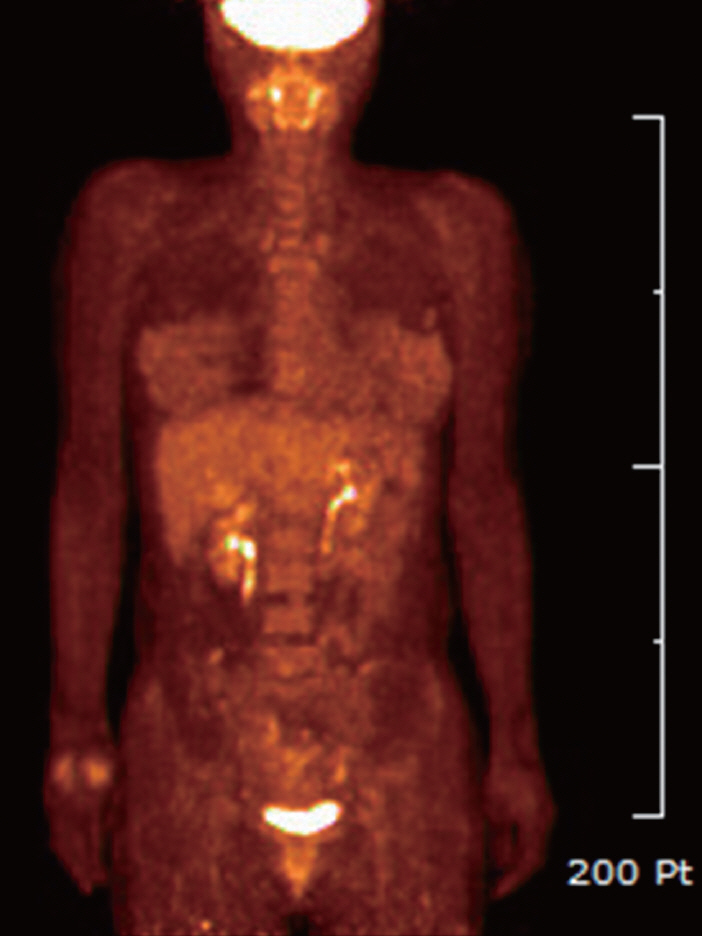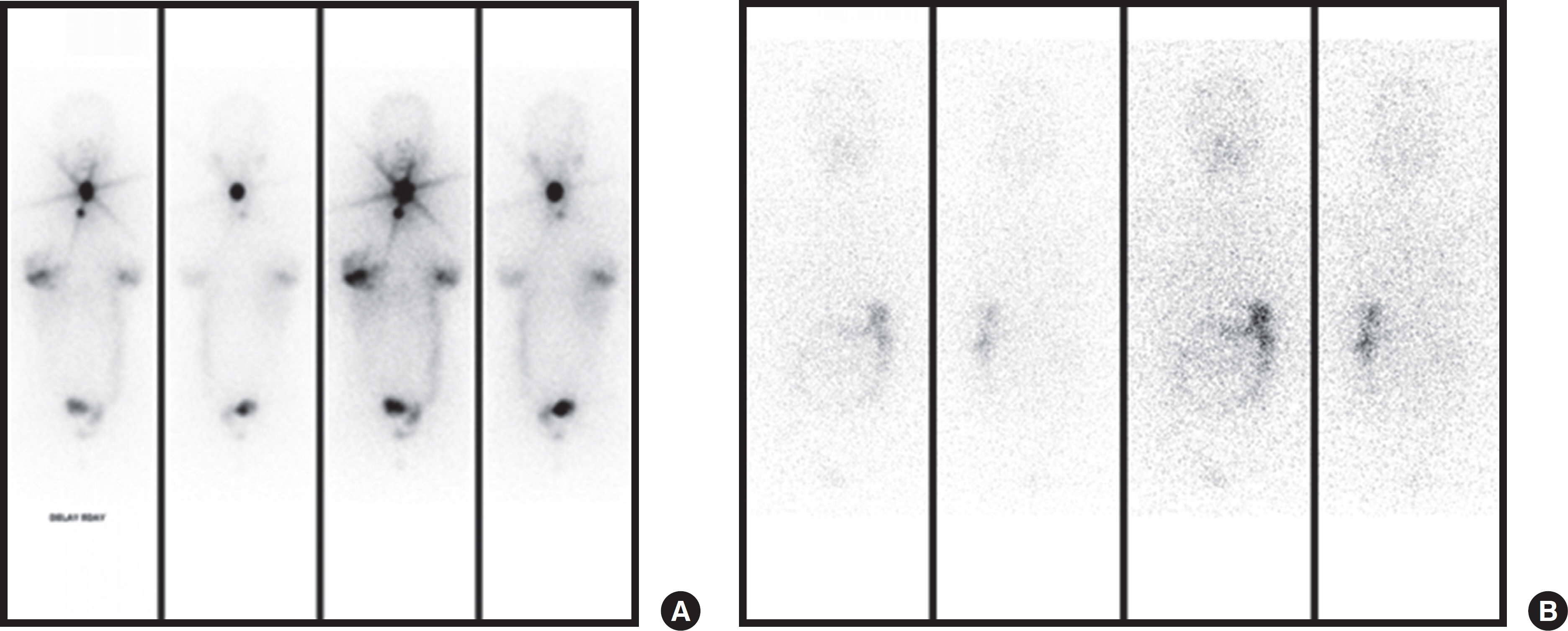Endocrinol Metab.
2011 Dec;26(4):345-347. 10.3803/EnM.2011.26.4.345.
Hyperprolactinemia-Associated Breast Uptake of Radioiodine Following 131I Postablation Scan in Differentiated Thyroid Cancer
- Affiliations
-
- 1Division of Endocrinology and Metabolism, Department of Internal Medicine, Korea University Anam Hospital, Korea University College of Medicine, Seoul, Korea.
- 2Division of Endocrinology and Metabolism, Department of Internal Medicine, Korea University Guro Hospital, Korea University College of Medicine, Seoul, Korea. kahlua99@hanmail.net
- 3Division of Endocrinology and Metabolism, Department of Internal Medicine, Korea University Ansan Hospital, Korea University College of Medicine, Ansan, Korea.
- KMID: 2169267
- DOI: http://doi.org/10.3803/EnM.2011.26.4.345
Abstract
- Scanning with whole-body 131I scintigraphy after surgery has been a valuable diagnostic modality in the surveillance of patients with differentiated thyroid cancer. Radioiodine uptake is rarely observed in non-lactating breast tissue, which mimics thyroid cancer metastasis. We now report a case of a 45-year-old female thyroid cancer patient who underwent radioiodine therapy, and in whom breast uptake of radioiodine was observed on a post-therapy whole body scan. Her serum prolactin level was elevated to 328 ng/mL at the time of the radioiodine uptake, and the hyperprolactinemia was induced by her antipsychotic medications. Six months after she discontinued that medication, her serum prolactin level was normalized to 12.6 ng/mL and breast uptake of iodine was no longer present in a follow-up whole body scan.
MeSH Terms
Figure
Reference
-
1. Baeumler GR, Joo KG. Radioactive iodine uptake by breasts. J Nucl Med. 27:149–151. 1986.2. Kao PF, Chang HY, Tsai MF, Lin KJ, Tzen KY, Chang CN. Breast uptake of iodine-131 mimicking lung metastases in a thyroid cancer patient with a pituitary tumour. Br J Radiol. 74:378–381. 2001.
Article3. Ronga G, Bruno R, Puxeddu E, Calcinaro F, Montesano T, Travascio L, Colandrea M, Durante C, Maranghi M, Filetti S, Russo D. Radioiodine uptake in non-lactating mammary glands: evidence for a causative role of hyperprolactinemia. Thyroid. 17:363–366. 2007.
Article4. Hammami MM, Bakheet S. Radioiodine breast uptake in nonbreastfeed-ing women: clinical and scintigraphic characteristics. J Nucl Med. 37:26–31. 1996.5. Arturi F, Russo D, Schlumberger M, du Villard JA, Caillou B, Vigneri P, Wicker R, Chiefari E, Suarez HG, Filetti S. Iodide symporter gene expression in human thyroid tumors. J Clin Endocrinol Metab. 83:2493–2496. 1998.6. Filetti S, Bidart JM, Arturi F, Caillou B, Russo D, Schlumberger M. Sodium/iodide symporter: a key transport system in thyroid cancer cell metabolism. Eur J Endocrinol. 141:443–457. 1999.
Article7. Dohán O, De la Vieja A, Paroder V, Riedel C, Artani M, Reed M, Ginter CS, Carrasco N. The sodium/iodide Symporter (NIS): characterization, regulation, and medical significance. Endocr Rev. 24:48–77. 2003.8. Wapnir IL, Goris M, Yudd A, Dohan O, Adelman D, Nowels K, Carrasco N. The Na+/I- symporter mediates iodide uptake in breast cancer metastases and can be selectively down-regulated in the thyroid. Clin Cancer Res. 10:4294–4302. 2004.
Article9. Cho JY, Léveillé R, Kao R, Rousset B, Parlow AF, Burak WE Jr, Mazzaferri EL, Jhiang SM. Hormonal regulation of radioiodide uptake activity and Na+/I- symporter expression in mammary glands. J Clin Endocrinol Metab. 85:2936–2943. 2000.
Article10. Riesco-Eizaguirre G, Santisteban P. A perspective view of sodium iodide symporter research and its clinical implications. Eur J Endocrinol. 155:495–512. 2006.
Article11. Kogai T, Taki K, Brent GA. Enhancement of sodium/iodide symporter expression in thyroid and breast cancer. Endocr Relat Cancer. 13:797–826. 2006.
Article12. Bruno R, Giannasio P, Ronga G, Baudin E, Travagli JP, Russo D, Filetti S, Schlumberger M. Sodium iodide symporter expression and radioiodine dis-tribution in extrathyroidal tissues. J Endocrinol Invest. 27:1010–1014. 2004.
Article13. Madhusoodanan S, Parida S, Jimenez C. Hyperprolactinemia associated with psychotropics–a review. Hum Psychopharmacol. 25:281–297. 2010.
Article14. Bakheet SM, Hammami MM. Patterns of radioiodine uptake by the lac-tating breast. Eur J Nucl Med. 21:604–608. 1994.
Article15. Renier C, Yao C, Goris M, Ghosh M, Katznelson L, Nowles K, Gambhir SS, Wapnir I. Endogenous NIS expression in triple-negative breast cancers. Ann Surg Oncol. 16:962–968. 2009.
Article
- Full Text Links
- Actions
-
Cited
- CITED
-
- Close
- Share
- Similar articles
-
- Radioiodine Therapy in a Patient with Papillary Thyroid Carcinoma associated with Breast Uptake ; Hyperprolactinemia due to Empty Sella Syndrome
- Incidental Findings of Intense Radioiodine Uptake in Struma Ovarii and Bilateral Nonlactating Breasts Simultaneously on Postablation ¹³¹I SPECT/CT for Papillary Thyroid Cancer
- Detection for Residual Thyroid Tissue and Metastatic Lesion after Total Thyroidectomy in Patients with Differentiated Thyroid Cancer: Comparison between Tc-99m Pertechnetate Scan and High Dose I-131 Therapy Scan
- Camprison of Diagnostic and Therapeutic scans in Patients with Differentiated Thyroid Cancer
- Surgical Methods for Radioiodine Refractory Thyroid Cancer



